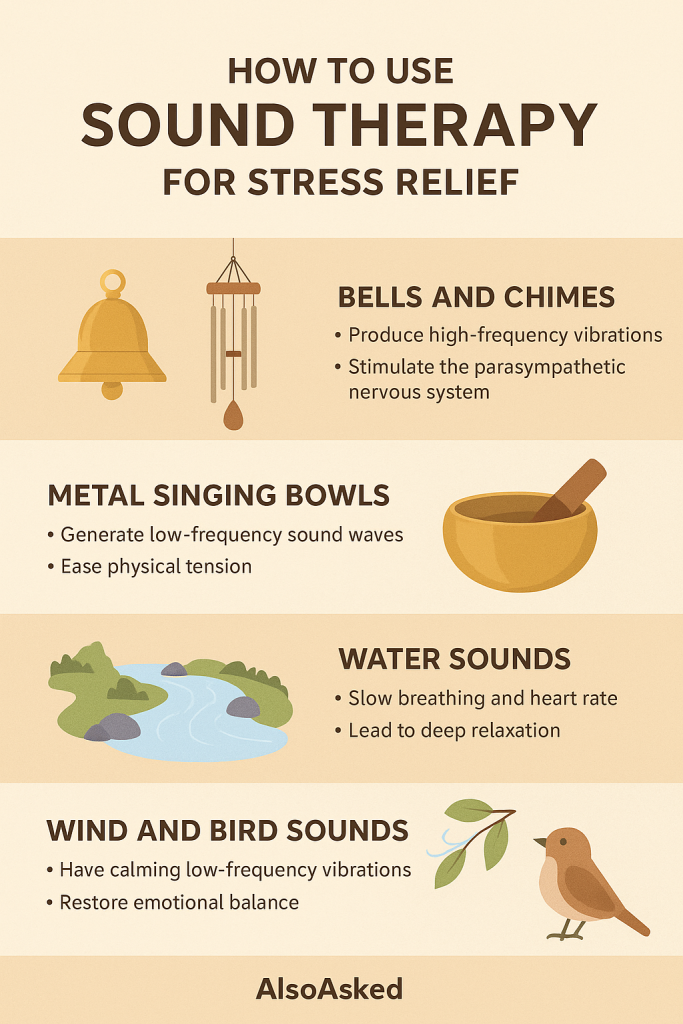In a noisy, fast-paced world, stress has become an unavoidable part of life. But there’s an ancient solution making a powerful comeback—sound therapy for stress relief using natural frequencies and traditional instruments. Unlike popular music or songs, these methods use vibrations from bells, metal cups, wind, and water to calm the mind and reset the body.
What Is Sound Therapy and How Does It Work?
Sound therapy is the use of specific sound frequencies to promote relaxation, emotional balance, and mental clarity. From Tibetan singing bowls to wind chimes, these instruments emit frequencies that interact with brainwaves. When we listen to these stress relieving sounds, our brain responds by shifting from a high-alert beta state to a calm and restorative alpha or theta state.
According to physics, every object, including the human body, vibrates at a natural frequency. When we are stressed, our internal vibrations become chaotic. By introducing calming sound waves for stress relief, we entrain the brain to follow the peaceful rhythm of nature and tradition.
Traditional Sound Tools for Stress Relief
Bells and Chimes
Bells have long been used in temples and rituals to create a sense of peace. The ringing sound produces harmonic overtones that gently cleanse the space and mind. The high-frequency vibrations of bells stimulate the parasympathetic nervous system, responsible for rest and digestion.

Metal Singing Bowls
Often called “sound baths,” singing bowls made of brass or bronze generate low-frequency stress relief sound waves. When the bowl is struck or rubbed, it produces a steady hum that penetrates deep into the body. These stress relieving recitations in the form of vibrations are felt rather than heard, easing physical tension and releasing emotional stress.
Scientific studies confirm that singing bowls emit frequencies between 100–600 Hz, which can promote relaxation, reduce anxiety, and even lower cortisol—the stress hormone.

Natural Sound Frequencies That Heal
Sound therapy doesn’t always require instruments. Nature itself is a powerful healer.
Water Sounds for Stress Relief
The sound of flowing rivers, rain, or ocean waves mimics the natural rhythm of the human heartbeat. These water-based sound stress relief experiences can slow breathing and heart rate, leading to deep relaxation. The frequency of flowing water usually lies within 50–200 Hz, ideal for calming the brain.
Wind and Air Movement
Wind whistling through trees or rustling leaves generates low-frequency vibrations that bring a meditative stillness. These natural tones help the brain disconnect from overstimulation and reconnect with inner peace.
Bird Calls and Forest Sounds
Birdsong in the morning has frequencies between 1 kHz to 8 kHz, which fall within the range that stimulates serotonin—the “feel-good” neurotransmitter. Bird sound therapy is proven to ease stress and restore emotional balance, especially for those overwhelmed by urban noise.

Physics Behind Sound Therapy
The foundation of stress relief sound therapy lies in the physics of resonance and entrainment:
- Resonance: The body absorbs sound vibrations. Natural frequencies resonate with our cells, gently correcting their disrupted rhythm.
- Entrainment: Brainwaves synchronize with external rhythms. Calming sounds guide brain activity into relaxed states (alpha and theta).
This explains why stress relieving sound baths and sound frequency stress relief tools have become central to holistic healing.
Conclusion: Embrace Natural Sound for Inner Peace
You don’t need expensive therapy to experience relief. Simply surround yourself with natural stress relief sounds or traditional instruments like bowls or bells. Whether it’s the gentle trickle of water, a chime in the wind, or the hum of a metal cup, these vibrations can restore peace in ways modern music cannot.
So the next time you feel overwhelmed, turn to the timeless power of nature’s sound. Let it ease your stress away—one vibration at a time.




I liked this concept
Thank You for your Review
Interesting✨
Thanks for your review
very nice publish, i definitely love this web site, carry on it